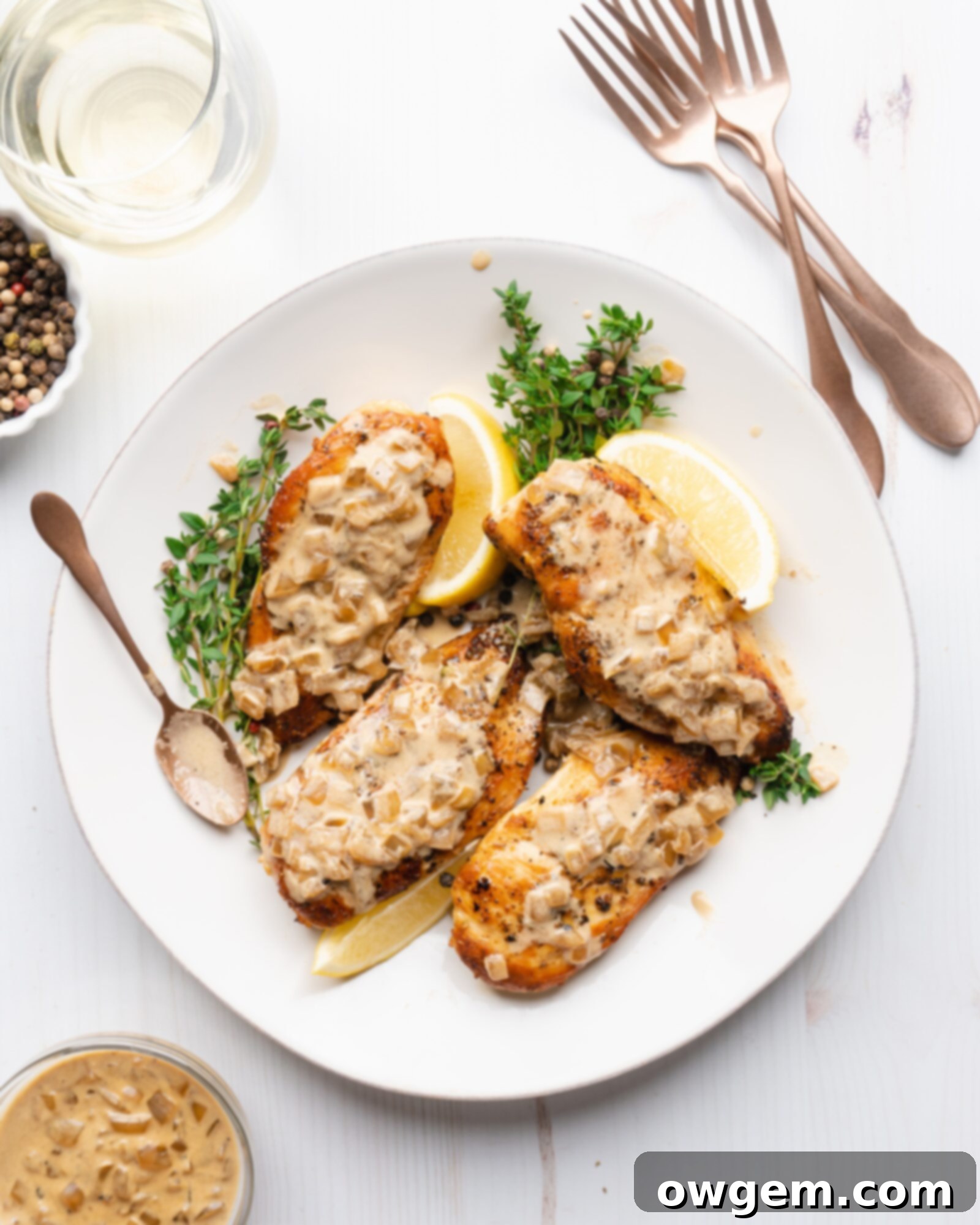Creamy White Wine Chicken Breasts: An Easy Pan Sauce Recipe for a Flavorful Weeknight Meal
Experience a culinary revelation with this exquisite recipe, transforming simple chicken breasts into a gourmet delight. The secret lies in a rich, flavorful pan sauce, masterfully crafted from the savory “fond” left behind after searing the chicken, then elevated with tender onions, aromatic shallots, a touch of luscious cream, and, most importantly – a generous splash of dry white wine! Prepare to be amazed as boneless, skinless chicken gets a major flavor overhaul, becoming incredibly tender and enveloped in a sauce so delicious it will make your taste buds sing. This dish isn’t just a meal; it’s an experience, bringing restaurant-quality flavors right to your dinner table with surprising ease.

Unlocking Flavor: My Journey to Cooking with Wine
Who doesn’t appreciate a good glass of wine? Whether it’s a crisp white, a robust red, or a delightful rosé – each offers its own unique charm. What truly captivates me about wine is the incredible depth and subtle nuances of its flavors, which extend far beyond just sipping. However, I must confess, there was a time when the idea of cooking with wine filled me with apprehension. Despite my love for drinking it, incorporating it into my culinary creations seemed like a daunting task, an art reserved only for professional chefs or those with advanced gastronomic skills. I imagined complex techniques and intricate flavor balances that felt beyond my reach.
My entire perspective changed during a memorable dining experience at a restaurant. I ordered beef short ribs, a dish I had enjoyed before, but this particular rendition was extraordinary. The short rib was unbelievably succulent, boasting such a profound depth of flavor that I had never tasted anything quite so delicious in my life. It was a revelation, a moment where the full potential of wine in cooking truly clicked for me. That single dish ignited my passion and curiosity, marking the beginning of my enduring love affair with cooking with wine. It taught me that this sophisticated ingredient wasn’t just for fancy restaurants; it was an accessible tool to elevate home cooking, adding layers of complexity and richness that simple ingredients often can’t achieve on their own.
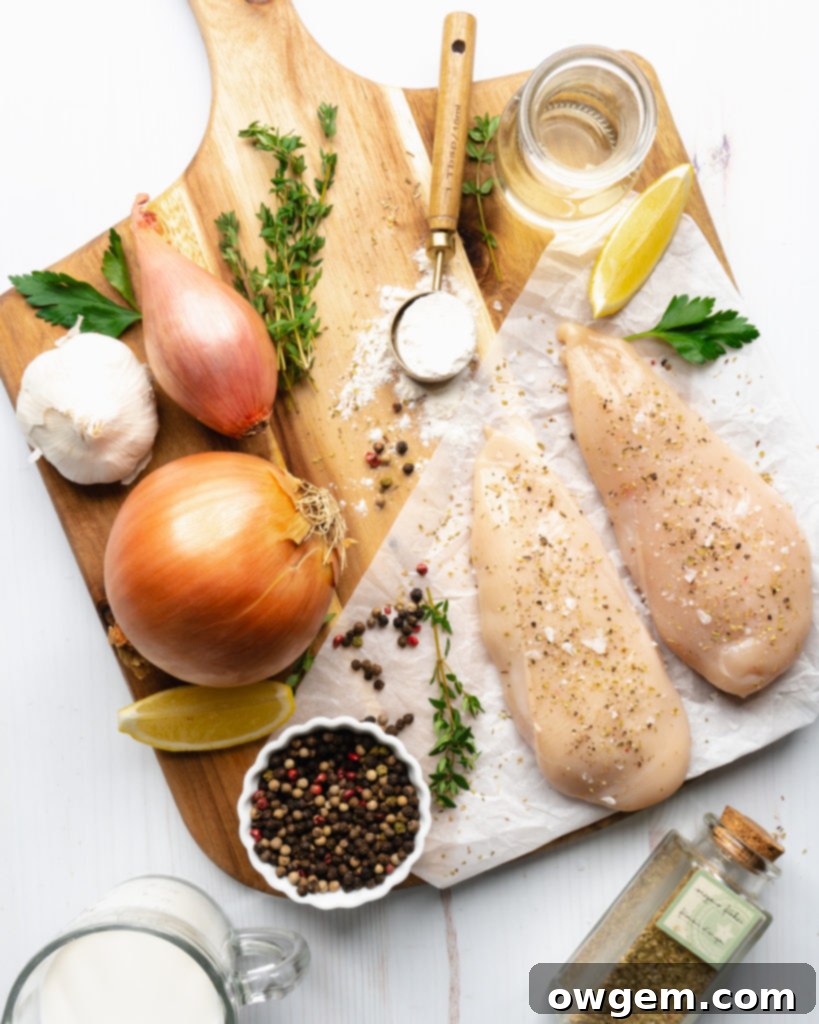
The Versatility of Wine in Culinary Applications
Wine is an incredibly versatile ingredient in the culinary arts, offering a spectrum of uses that can transform ordinary dishes into extraordinary meals. Its applications range from tenderizing tough cuts of meat to enhancing the overall flavor profile of a dish. One of its primary uses is as a marinade component, where the natural acidity in wine works wonders. The acids in wine help to break down the connective tissues in meat, resulting in a more tender and juicy texture, while also infusing it with subtle, complex flavors that can’t be achieved otherwise. This makes wine an excellent choice for marinades for chicken, beef, or pork.
Beyond tenderizing, wine is a powerful flavor enhancer. It can be used to deglaze a pan, a technique where wine is added to a hot pan after searing meat or vegetables, dissolving the caramelized “fond” (the browned bits) stuck to the bottom. These bits are packed with concentrated flavor, and deglazing with wine creates a rich base for sauces and gravies. The alcohol in the wine quickly evaporates, leaving behind a concentrated essence of its fruity, earthy, or spicy notes. Furthermore, wine can be reduced into a sophisticated sauce on its own, adding a velvety texture and intense flavor to dishes. It can also serve as a steaming liquid, imparting delicate aromas to fish or vegetables. When cooking with wine, the alcohol boils off, taking with it any harsh alcoholic notes. What remains is a deeply sweet, aromatic, and slightly acidic flavor that complements a wide array of foods beautifully, making your chicken dishes, in particular, stand out with a gourmet touch.
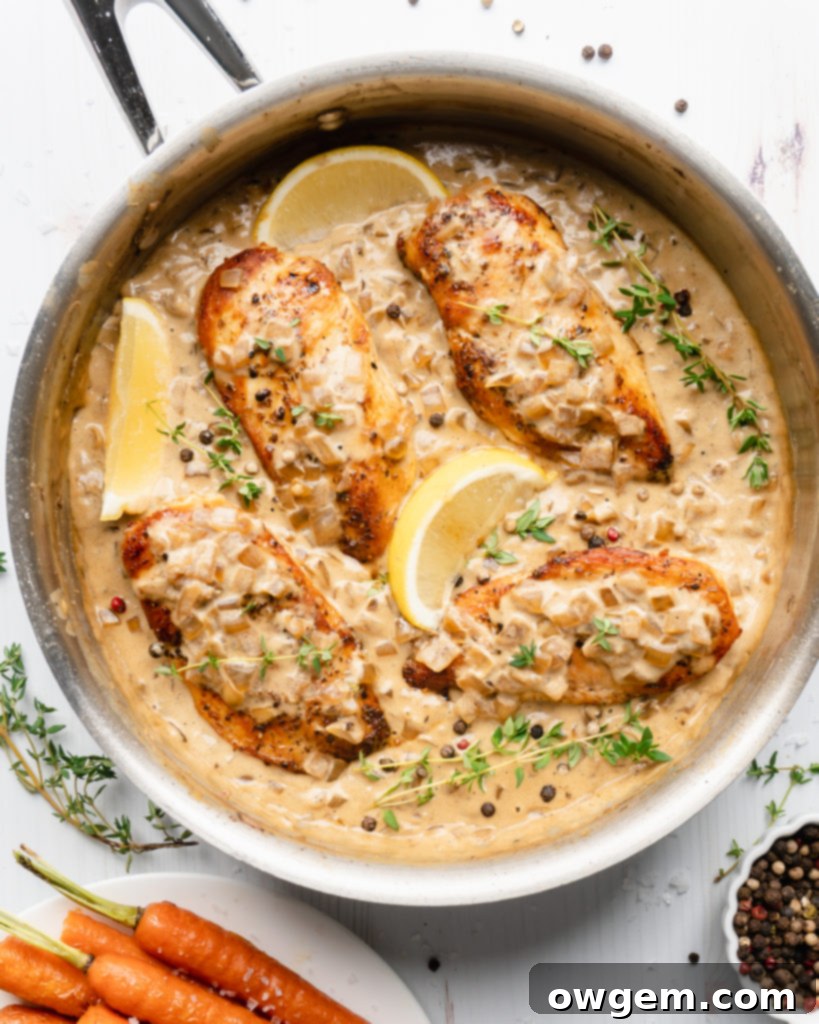
Essential Considerations When Cooking with Wine
While cooking with wine offers immense rewards, there are a few crucial guidelines to keep in mind to ensure the best results. The cardinal rule of cooking with wine is simple: **DO NOT USE WINE YOU WOULDN’T DRINK.** This isn’t an endorsement of only using expensive vintages; rather, it’s a strong warning against using “cooking wine.” Cooking wine, often found in the vinegar aisle, is, frankly, unpalatable. These products are typically loaded with salt, which is added as a preservative to extend their shelf life. However, when cooking wine is reduced in a dish, this high concentration of salt becomes intensified, leading to an overwhelmingly salty and unappetizing taste that can ruin your entire meal. Instead, opt for an inexpensive but drinkable bottle from your local grocery store – a sub-$10 bottle of actual wine will always yield far superior results compared to any “cooking wine.”
Another important consideration is the sweetness of the wine. Generally, it’s best to avoid sweet wines for savory dishes. While sweet wines certainly have their place in culinary applications, such as in desserts, baking, or specific glazes, dry wines are almost always a better choice for savory cooking. This is because as the alcohol cooks off, the sugar concentration in the wine increases. Using a sweet wine can quickly make your dish overly cloying and unbalanced. Therefore, choose a dry white or red wine unless your recipe specifically calls for a sweet variety. Lastly, be mindful of the wine’s acidity. Similar to sugar, the acidity also intensifies as the wine reduces. This concentration can significantly impact the overall flavor balance of your dish. To compensate, it’s wise to reduce other acidic ingredients in your recipe – such as vinegar or lemon juice – when cooking with wine. Only use wine when you specifically desire an extra tartness or brightness that complements the other components of your meal. Always taste as you go and adjust seasonings and acids accordingly to achieve a harmonious flavor profile.
Selecting the Right Wine for Your Dish
Choosing the correct wine for your cooking can significantly impact the final flavor of your dish. My experience has shown that certain wine characteristics consistently perform better in savory recipes. For white wines, look for descriptions like “crisp,” “light,” or “fruity.” These wines, such as Sauvignon Blanc or Pinot Grigio, often contribute bright, refreshing notes without overpowering the other ingredients. Their vibrant acidity can cut through richness, while their fruity undertones (think green apple, citrus, or pear) add a subtle sweetness that balances savory elements. Conversely, “oaky” whites, like some heavily oaked Chardonnays, tend not to pair well in most savory dishes. The intense oak flavors can become bitter or contribute an overwhelming, woody taste when concentrated, clashing with delicate flavors.
When it comes to red wines, those with “berry” or “fruity” tones and low-to-moderate tannins are generally the best choices for cooking. Varieties like Pinot Noir or Merlot offer pleasant fruitiness and a smoother mouthfeel. High tannin reds, such as Cabernet Sauvignon or Syrah (unless specifically for a long-simmered, rich beef stew), can result in a chalky or overly bitter sensation when cooked down, which can be particularly noticeable in quick pan sauces. The tannins, which give red wines their astringency, become concentrated and can lead to an undesirable texture and flavor. However, as with all rules in cooking, there are exceptions. For instance, some robust beef dishes might benefit from a moderate-to-high tannin wine, but that’s a topic for a more in-depth discussion at a later date. For most everyday cooking, especially with chicken or lighter meats, sticking to lower-tannin options is always a safe bet.
Good Whites for Cooking: Sauvignon Blanc (for bright, herbaceous notes), Pinot Grigio/Gris (crisp and dry), Pinot Blanc (lighter, subtle fruit), Semillon (fuller body, nutty notes), White Bordeaux (blend offering balance).
Good Reds for Cooking: Pinot Noir (light, fruity, low tannin), Sangiovese (savory, cherry notes), Zinfandel (bold fruit, moderate tannin), Chianti (earthy, red fruit), Merlot (soft, plum notes).
Again, generally, low-tannin red wines are always a safe bet, as are fruity and crisp whites, providing a delightful foundation for your culinary endeavors.

Crafting the Perfect White Wine Cream Sauce for Chicken
This recipe for chicken with white wine sauce promises a truly wonderful dining experience, marked by a bright, vibrant flavor profile. The star of the show is the pan sauce, which is ever-so-slightly fruity, simultaneously rich, and beautifully creamy. Its texture and consistency are remarkably similar to a luxurious gravy, making it perfect for coating and complementing your tender chicken. One of the joys of this sauce is its adaptability to your personal preference. Sometimes, I choose to strain out all the small pieces of onion and garlic after cooking, resulting in an exquisitely silky-smooth sauce that glides effortlessly over the chicken and accompanying sides. Other times, I prefer to leave these aromatic bits in, giving the sauce a more rustic, chunky texture and an even more pronounced depth of flavor.
For those who enjoy a more intense onion and garlic presence but desire a smooth consistency, blending the sauce after cooking is an excellent option. This technique creates a delicious, uniform sauce with a stronger, more integrated flavor from the aromatics. This versatile white wine sauce pairs exceptionally well with a variety of accompaniments. I personally love to serve it generously spooned over tender baby potatoes, allowing them to soak up every drop of flavor. However, it’s equally delightful over pasta, creating a quick and elegant meal, or even drizzled over blanched asparagus for a lighter option. Don’t limit yourself – it would also be fantastic with rice, polenta, or even just crusty bread to sop up all the goodness.
If you, like me, find yourself craving more of this incredible sauce – perhaps for a larger gathering or simply because you adore extra sauce over your potatoes – it’s incredibly easy to adjust. To increase the amount of sauce, I simply multiply all the sauce ingredients (onions, shallots, garlic, flour, white wine, half & half, and thyme) by 1.5 times. This slight adjustment yields a more abundant sauce without compromising its perfect balance of flavors and textures. This white wine chicken recipe is not just about a meal; it’s about elevating your home cooking with simple techniques and high-impact ingredients, creating a dish that feels both comforting and sophisticated.
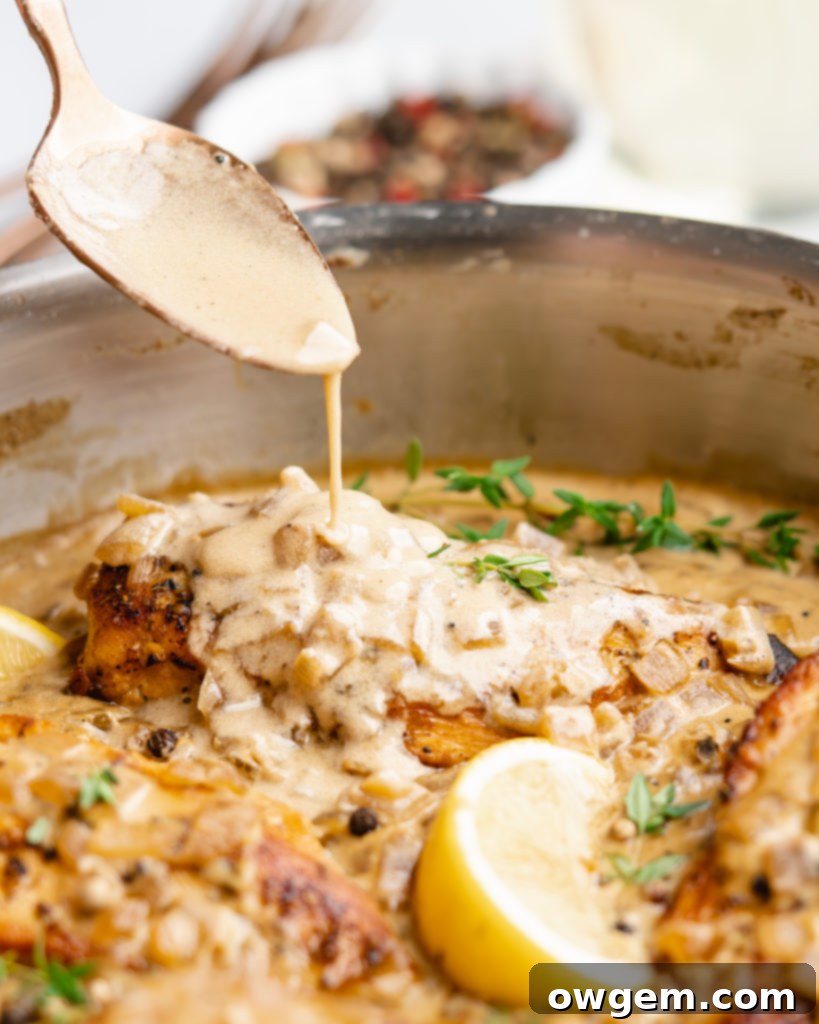
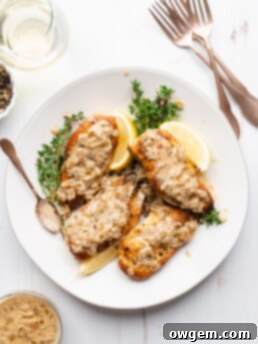
Get the Recipe:
Flavorful Chicken Breasts with Creamy White Wine Sauce
Pin
Rate
Ingredients
Optional: White Wine Marinade for Enhanced Flavor
- 1 1/2 cups Dry White Wine
- 1/2 cup Extra Virgin Olive Oil
- 2 tbsp Italian Seasoning
- 2 tbsp Crushed Garlic
- 1 tsp Kosher Salt
Chicken and Creamy White Wine Pan Sauce
- 4 Boneless, Skinless, Chicken Breasts
- 3 tbsp Butter,, divided for cooking
- 1 Medium Onion,, finely diced
- 1 Large Shallot,, finely diced
- 2 tbsp Crushed Garlic
- 1 tbsp All-purpose Flour
- 1/2 cup Dry White Wine
- 1 1/2 cups Half & Half
- 5 sprigs Fresh Thyme
- 2 tsp Butter,, for finishing sauce
- 1 tsp Fresh Lemon Juice,, for brightness
- Salt & Pepper,, to taste
Instructions
White Wine Marinade (Optional but Recommended)
-
Combine all marinade ingredients (dry white wine, extra virgin olive oil, Italian seasoning, crushed garlic, and kosher salt) in a large, sealable plastic bag or a shallow dish. Add the chicken breasts to the marinade, ensuring they are fully coated. Marinate for at least 2 hours in the refrigerator, or for even deeper flavor and tenderness, preferably overnight (up to 12-18 hours).
Preparing the Chicken and White Wine Pan Sauce
-
Begin by preheating your oven to 400°F (200°C). This ensures your chicken will finish cooking perfectly after searing.
-
Melt 1 tablespoon of butter in a large, oven-safe frying pan (such as cast iron or stainless steel) over medium heat. If using marinated chicken, remove it from the marinade and pat dry thoroughly with paper towels to ensure a good sear. Season the chicken breasts generously with salt, pepper, and additional Italian seasoning if desired. Carefully place the seasoned chicken breasts into the hot pan and brown them well on both sides, cooking for about 3-4 minutes per side until a beautiful golden crust forms. Once browned, transfer the chicken onto a baking sheet and place it in the preheated oven to finish cooking for 15-20 minutes, or until an internal temperature of 165°F (74°C) is reached, depending on the thickness of your chicken breasts.
-
Using the same frying pan, which should have delicious browned bits (fond) stuck to the bottom, melt the remaining 2 tablespoons of butter over medium heat. Add the diced onions and shallots to the pan and season lightly with salt. Using a wooden spoon or spatula, scrape at the bottom of the pan to release all those flavorful browned bits. Cook the onions and shallots until they are tender and translucent, which should take about 7 minutes. Next, add the crushed garlic and sauté for another 1-2 minutes until fragrant, being careful not to burn it. Then, sprinkle the flour into the pan, mixing it well with the onions and garlic until fully combined to form a roux, and cook for 1 minute to cook out the raw flour taste.
-
Pour the dry white wine into the pan. Immediately scrape the bottom of the pan again to release any remaining browned bits; this is crucial for maximum flavor. Bring the wine to a simmer and cook until it has reduced by half, which usually takes about 3 minutes. Then, gradually whisk in the half & half, ensuring no lumps form. Add the whole thyme sprigs to the sauce. Bring the sauce to a gentle bubble, then reduce the heat to a low simmer and cook, stirring occasionally, until the sauce thickens to a consistency similar to gravy. Once thickened, remove and discard the thyme sprigs. Season the sauce to taste with salt and freshly ground black pepper, and finish it off by stirring in the fresh lemon juice and the final 2 teaspoons of butter for richness and a glossy sheen.
-
(Optional) If you prefer a silky-smooth sauce, remove the pan from the heat and carefully strain the sauce over a fine-mesh sieve into a clean bowl, pressing down on the solids to extract all liquid. This will leave you with a perfectly smooth gravy-like sauce.
-
Once the chicken is cooked through and the sauce is ready, slice the chicken breasts (or serve them whole) and generously pour the warm, creamy white wine sauce over them. Serve immediately with your favorite sides like roasted potatoes, pasta, or steamed green vegetables. Enjoy this deliciously elevated chicken dinner!
